#Anglo-Belgian art
Text

Night View of a Factory, Alfred William Finch, 1910s
#art#art history#Alfred William Finch#landscape#landscape painting#cityscape#night scene#Neo-Impressionism#Belgian art#Anglo-Belgian art#20th century art#modern art#oil on canvas#UPM-Kymmene Cultural Foundation
130 notes
·
View notes
Text
"The most fashionable bathing station in all Europe". British industrialists and American mining investors plotting the colonization of the Congo, while mingling at Ostend's seaside vacation resorts. Extracting African life to build European railways, hotels, palaces, suburbs, and other modern(ist) infrastructure. "Towards infinity!"
---
In 1885, King Leopold II achieved an astonishing and improbable goal: he claimed a vast new realm of his own devising, a conjury on a map called [...] the Congo Free State. [...] [A] fictional state owned by the king, ruled by decree, and run from Brussels from 1885 to 1908. [...] This was [...] a private entrepreneurial venture [for the king]. The abundance of ivory, timber, and wild rubber found in this enormous territory brought sudden and spectacular profits to Belgium, the king, and a web of interlocking concession companies. The frenzy to amass these precious resources unleashed a regime of forced labor, violence [millions of deaths], and unchecked atrocities for Congolese people. These same two and a half decades of contact with the Congo Free State remade Belgium [...] into a global powerhouse, vitalized by an economic boom, architectural burst, and imperial surge.
Congo profits supplied King Leopold II with funds for a series of monumental building projects [...]. Indeed, Belgian Art Nouveau exploded after 1895, created from Congolese raw materials and inspired by Congolese motifs. Contemporaries called it “Style Congo,” [...]. The inventory of this royal architecture is astonishing [...]. [H]istorical research [...] recovers Leopold’s formative ideas of architecture as power, his unrelenting efforts to implement them [...]. King Leopold II harbored lifelong ambitions to “embellish” and beautify the nation [...]. [W]ith his personal treasury flush with Congo revenue, [...] Leopold - now the Roi Batisseur ("Builder King") he long aimed to be - planned renovations explicitly designed to outdo Louis XIV's Versailles. Enormous greenhouses contained flora from every corner of the globe, with a dedicated soaring structure completed specifically to house the oversize palms of the Congolese jungles. [...]
---
The Tervuren Congo palace [...]. Electric tramways were built and a wide swath of avenue emerged. [...] [In and around Brussels] real estate developers began to break up lots [...] for suburban mansions and gardens. Between 1902 and 1910, new neighborhoods with luxury homes appeared along the Avenue [...]. By 1892, Antwerp was not only the port of call for trade but also the headquarters of the most profitable of an interlinking set of banks and Congo investment companies [...]. As Antwerp in the 1890s became once again the “Queen of the Scheldt,” the city was also the home of what was referred to as the “Queen of Congo companies.” This was the ABIR, or Anglo-Belgian India Rubber Company, founded in 1892 with funds from British businessman “Colonel” John Thomas North [...].
Set on the seaside coast, Belgium’s Ostend was the third imperial cityscape to be remade by King Leopold [...] [in a] transformation [that] was concentrated between 1899 and 1905 [...]. Ostend encompassed a boomtown not of harbor and trade, like Antwerp, but of beachfront and leisure [...] [developed] as a "British-style" seaside resort. [...] Leopold [...] [w]as said to spend "as much time in Ostend as he did in Brussels," [...]. Ostend underwent a dramatic population expansion in a short period, tripling its inhabitants from 1870–1900. [...] Networks of steamers, trams, and railway lines coordinated to bring seasonal visitors in, and hotels and paved walkways were completed. [...] [A]nd Leopold’s favorite spot, the 1883 state-of-the-art racetracks, the Wellington Hippodrome. Referred to with an eye-wink as “the king incognito” (generating an entire genre of photography), visitors to the seaside could often see Leopold in his top hat and summer suit [...], riding his customized three-wheeled bicycle [...]. By 1900, Ostend’s expansion and enhancement made it known as “the Queen of the Belgian seaside resorts” and “the most fashionable bathing station in all Europe.” Opulence, convenience, and spectacle brought the Shah of Persia, American tycoons, European aristocrats, and Belgian elites, among others, to Ostend.
---
Leopold’s interventions and the Congo Free State personnel and proceeds played three pivotal and understudied roles in this transformation, all of which involved ABIR [British industrialists].
First, it was at Ostend that an early and decisive action was taken to structure the “red rubber” regime and set it in motion. In 1892, jurists such as [E.P.] had ruled, contravening [...] trade laws, that the king was entitled to claim the Congo as his domanial property [...]. Leopold [...] devised one part of that royal domain as a zone for private company concessions [...] to extract and export wild rubber.
Soon after, in 1892, King Leopold happened to meet the British “Colonel” John Thomas North at the Ostend Hippodrome. North, a Leeds-born mechanic [...] had made a fortune speculating on Chilean nitrates in the 1880s. He owned monopoly shares in nitrate mines and quickly expanded to acquire monopolies in Chilean freight railways, water supplies, and iron and coal mines. By 1890 North was a high-society socialite worth millions [...]. Leopold approached North at the Ostend racecourse to provide the initial investments to set up the Anglo-Belgian India Rubber Company (ABIR). [...]
---
One visible sign of Ostend’s little-known character as Congo boomtown was the Royal Palace Hotel, a lavish property next to the king’s Royal Domain, which opened in 1899. With hundreds of rooms and a broad sweep of acreage along the beachfront, the palace “occupied the largest space of any hotel in Europe.” [...]
King Leopold met American mining magnate Thomas Walsh there, and as with North, the meeting proved beneficial for his Congo enterprise: Leopold enlisted Walsh to provide assessments of some of his own Congo mining prospects. The hotel was part of [...] [a major European association of leisure profiteers] founded in 1894, that began to bundle luxury tourism and dedicated railway travel, and whose major investors were King Leopold, Colonel North [...].
At the height of Congo expansionism, fin-de-siècle Antwerp embodied an exhilarated launch point [...]. Explorers and expeditioners set sail for Matadi after 1887 with the rallying call “Vers l’infini!” (“towards infinity!”) [...].
---
Text above by: Debora Silverman. "Empire as Architecture: Monumental Cities the Congo Built in Belgium". e-flux Architecture (Appropriations series). May 2024. At: e-flux.com/architecture/appropriations/608151/empire-as-architecture-monumental-cities-the-congo-built-in-belgium/ [Bold emphasis and some paragraph breaks/contractions added by me. Italicized first paragraph/heading in this post was added by me. Presented here for commentary, teaching, criticism.]
#tidalectics#ecology#multispecies#abolition#this full article has far more info about leopolds obsession with opulence and all the many infrastructure projects in belgium he sponsored#full article also expands more on congolese art and anticolonial art projects that criticize belgian architecture#eflux did several articles focusing on anticolonial responses to belgian extraction and art noveau and modernist architecture#including a piece on spectacle of belgian worlds fair and human zoos#silverman has very extensive research history#ecologies#geographic imaginaries
102 notes
·
View notes
Text
On this day in Wikipedia: Friday, 29th March
Welcome, vitajte, ongi etorri, ողջու՜յն (voġčuyn) 🤗
What does @Wikipedia say about 29th March through the years 🏛️📜🗓️?

29th March 2023 🗓️ : Death - Vivan Sundaram
Vivan Sundaram, Indian contemporary artist (b. 1943)
"Vivan Sundaram (28 May 1943 – 29 March 2023) was an Indian contemporary artist. He worked in many different medias, including painting, sculpture, printmaking, photography, installation, and video art, and his work was politically conscious and highly intertextual in nature. His work constantly..."

Image licensed under CC BY 3.0? by George Quasha
29th March 2019 🗓️ : Death - Agnès Varda
Agnès Varda, French film director (b. 1928)
"Agnès Varda (French: [aɲɛs vaʁda] ; born Arlette Varda; 30 May 1928 – 29 March 2019) was a Belgian-born film director, screenwriter, photographer, and artist with French and Greek origins. Varda's work employed location shooting in an era when the limitations of sound technology made it easier and..."

Image by Unknown authorUnknown author
29th March 2014 🗓️ : Event - Same-sex marriage in the United Kingdom
The first same-sex marriages in England and Wales took place following the passage of the Marriage (Same Sex Couples) Act 2013.
"Same-sex marriage is legal in all parts of the United Kingdom. As marriage is a devolved legislative matter, different parts of the United Kingdom legalised at different times; it has been recognised and performed in England and Wales since March 2014, in Scotland since December 2014, and in..."
29th March 1974 🗓️ : Event - Shaanxi
A group of farmers in the Chinese province of Shaanxi discovered a vast collection of terracotta statues (pictured) depicting the armies of Qin Shi Huang, the first emperor of China.
"Shaanxi is a landlocked province of China. Officially part of Northwest China, it borders the province-level divisions of Shanxi (NE, E), Henan (E), Hubei (SE), Chongqing (S), Sichuan (SW), Gansu (W), Ningxia (NW) and Inner Mongolia (N). Shaanxi covers an area of over 205,000 km2 (79,151 sq mi) with..."

Image licensed under CC BY-SA 4.0? by N509FZ
29th March 1924 🗓️ : Death - Charles Villiers Stanford
Charles Villiers Stanford, Irish composer and conductor (b. 1852)
"Sir Charles Villiers Stanford (30 September 1852 – 29 March 1924) was an Anglo-Irish composer, music teacher, and conductor of the late Romantic era. Born to a well-off and highly musical family in Dublin, Stanford was educated at the University of Cambridge before studying music in Leipzig and..."

Image by Bassano Ltd
29th March 1824 🗓️ : Birth - Ludwig Büchner
Ludwig Büchner, German physiologist, physician, and philosopher (d. 1899)
"Friedrich Karl Christian Ludwig Büchner (29 March 1824 – 30 April 1899) was a German philosopher, physiologist and physician who became one of the exponents of 19th-century scientific materialism...."

Image by Unknown authorUnknown author
29th March 🗓️ : Holiday - Boganda Day (Central African Republic)
"This is a list of public holidays in the Central African Republic..."
0 notes
Text
Four O’Clock In The Afternoon
Volume 2: Cosette; Book 1: Waterloo; Chapter 6: Four O’Clock In The Afternoon
Towards four o’clock the condition of the English army was serious. The Prince of Orange was in command of the centre, Hill of the right wing, Picton of the left wing. The Prince of Orange, desperate and intrepid, shouted to the Hollando-Belgians: “Nassau! Brunswick! Never retreat!” Hill, having been weakened, had come up to the support of Wellington; Picton was dead. At the very moment when the English had captured from the French the flag of the 105th of the line, the French had killed the English general, Picton, with a bullet through the head. The battle had, for Wellington, two bases of action, Hougomont and La Haie-Sainte; Hougomont still held out, but was on fire; La Haie-Sainte was taken. Of the German battalion which defended it, only forty-two men survived; all the officers, except five, were either dead or captured. Three thousand combatants had been massacred in that barn. A sergeant of the English Guards, the foremost boxer in England, reputed invulnerable by his companions, had been killed there by a little French drummer-boy. Baring had been dislodged, Alten put to the sword. Many flags had been lost, one from Alten’s division, and one from the battalion of Lunenburg, carried by a prince of the house of Deux-Ponts. The Scotch Grays no longer existed; Ponsonby’s great dragoons had been hacked to pieces. That valiant cavalry had bent beneath the lancers of Bro and beneath the cuirassiers of Travers; out of twelve hundred horses, six hundred remained; out of three lieutenant-colonels, two lay on the earth,—Hamilton wounded, Mater slain. Ponsonby had fallen, riddled by seven lance-thrusts. Gordon was dead. Marsh was dead. Two divisions, the fifth and the sixth, had been annihilated.
Hougomont injured, La Haie-Sainte taken, there now existed but one rallying-point, the centre. That point still held firm. Wellington reinforced it. He summoned thither Hill, who was at Merle-Braine; he summoned Chassé, who was at Braine-l’Alleud.
The centre of the English army, rather concave, very dense, and very compact, was strongly posted. It occupied the plateau of Mont-Saint-Jean, having behind it the village, and in front of it the slope, which was tolerably steep then. It rested on that stout stone dwelling which at that time belonged to the domain of Nivelles, and which marks the intersection of the roads—a pile of the sixteenth century, and so robust that the cannon-balls rebounded from it without injuring it. All about the plateau the English had cut the hedges here and there, made embrasures in the hawthorn-trees, thrust the throat of a cannon between two branches, embattled the shrubs. There artillery was ambushed in the brushwood. This punic labor, incontestably authorized by war, which permits traps, was so well done, that Haxo, who had been despatched by the Emperor at nine o’clock in the morning to reconnoitre the enemy’s batteries, had discovered nothing of it, and had returned and reported to Napoleon that there were no obstacles except the two barricades which barred the road to Nivelles and to Genappe. It was at the season when the grain is tall; on the edge of the plateau a battalion of Kempt’s brigade, the 95th, armed with carabines, was concealed in the tall wheat.
Thus assured and buttressed, the centre of the Anglo-Dutch army was well posted. The peril of this position lay in the forest of Soignes, then adjoining the field of battle, and intersected by the ponds of Groenendael and Boitsfort. An army could not retreat thither without dissolving; the regiments would have broken up immediately there. The artillery would have been lost among the morasses. The retreat, according to many a man versed in the art,—though it is disputed by others,—would have been a disorganized flight.
To this centre, Wellington added one of Chassé’s brigades taken from the right wing, and one of Wincke’s brigades taken from the left wing, plus Clinton’s division. To his English, to the regiments of Halkett, to the brigades of Mitchell, to the guards of Maitland, he gave as reinforcements and aids, the infantry of Brunswick, Nassau’s contingent, Kielmansegg’s Hanoverians, and Ompteda’s Germans. This placed twenty-six battalions under his hand. The right wing, as Charras says, was thrown back on the centre. An enormous battery was masked by sacks of earth at the spot where there now stands what is called the “Museum of Waterloo.” Besides this, Wellington had, behind a rise in the ground, Somerset’s Dragoon Guards, fourteen hundred horse strong. It was the remaining half of the justly celebrated English cavalry. Ponsonby destroyed, Somerset remained.
The battery, which, if completed, would have been almost a redoubt, was ranged behind a very low garden wall, backed up with a coating of bags of sand and a large slope of earth. This work was not finished; there had been no time to make a palisade for it.
Wellington, uneasy but impassive, was on horseback, and there remained the whole day in the same attitude, a little in advance of the old mill of Mont-Saint-Jean, which is still in existence, beneath an elm, which an Englishman, an enthusiastic vandal, purchased later on for two hundred francs, cut down, and carried off. Wellington was coldly heroic. The bullets rained about him. His aide-de-camp, Gordon, fell at his side. Lord Hill, pointing to a shell which had burst, said to him: “My lord, what are your orders in case you are killed?” “To do like me,” replied Wellington. To Clinton he said laconically, “To hold this spot to the last man.” The day was evidently turning out ill. Wellington shouted to his old companions of Talavera, of Vittoria, of Salamanca: “Boys, can retreat be thought of? Think of old England!”
Towards four o’clock, the English line drew back. Suddenly nothing was visible on the crest of the plateau except the artillery and the sharpshooters; the rest had disappeared: the regiments, dislodged by the shells and the French bullets, retreated into the bottom, now intersected by the back road of the farm of Mont-Saint-Jean; a retrograde movement took place, the English front hid itself, Wellington drew back. “The beginning of retreat!” cried Napoleon.
1 note
·
View note
Photo

Emile Antoine Verpilleaux Colour Woodcut ‘The River from Waterloo Bridge’ 1927.
(via tadpoley)
#art#woodcut#cityscape print#holzschnitt#Emile Antoine Verpilleaux#vintage artworks#european artworks#landschaften#landscape print#20th century print#anglo-belgian artist#london 1920s#woodblock print#wood engraving#1927
27 notes
·
View notes
Photo










Dorothy Brett (1883 - 1977) was an Anglo-American painter, remembered as much for her social life as for her art. Born into an aristocratic British family, she lived a sheltered early life. During her student years at the Slade School of Art, she associated with Dora Carrington, Barbara Hiles and the Bloomsbury group. Among the people she met was novelist D.H. Lawrence, and it was at his invitation that she moved to Taos, New Mexico in 1924. She remained there for the rest of her life, becoming an American citizen in 1938.
"Dorothy Eugenie Brett was born November 10, 1883. She was the eldest daughter of the second Viscount Esher, Reginald Baliol Brett, who was the Liberal MP for Penryn and Falmouth. Her mother was Eleanor van de Weyer, the daughter of the Belgian ambassador to the court of St. James and a close advisor to Queen Victoria. She was called ‘Doll’ by her family, and like many upper class children of the Victorian era she was raised separately from her parents, receiving little formal education. She went to dancing classes with members of the royal family at Windsor Castle under the supervision of Queen Victoria, but had little contact with other children her own age, apart from her two elder bothers and younger sister sylvia who scandalised the family by becoming the Ranee of Sarawak.
This state of being secluded persisted until she was in her early twenties, and was exacerbated by a progressive deafness following an attack of appendicitis. Her attempts to make relationships were met with disapproval by her parents. She was packed off to their summer house in Scotland. But whilst she was there some of her drawings were seen by Sir Ian Hamilton, a friend of the family who persuaded her parents to send her to art school.
She was accepted into the Slade School on a provisional basis in the autumn of 1910, which turned out to be good timing and a propitious move. She was taught by Henry Tonks, and came into contact with a talented coterie of fellow students who like her were throwing off the shackles of the Victorian age and forging a new form of Bohemianism. She met and befriended Dora Carrington, Mark Gertler, David Bomberg, Stanley Spencer, and Isaac Rosenberg. It was a tradition at the school to refer to everyone by their surname, so she became ‘Brett’ to everyone but her family, in the same way that Dora Carrington was addressed simply as ‘Carrington’."
Continue reading https://mantex.co.uk/dorothy-brett-biography/
13 notes
·
View notes
Photo


“The Rose From Armida's Garden”, 1894, by Marie Spartali Stillman (British painter, 1844-1927).
~ Marie was the daughter of Michael Spartali, a wealthy cotton merchant who acted as Greek consul general in London from 1866, and the family belonged to the large Anglo-Greek community that played such a prominent part in the annals of Victorian art. Marie and her sister Christina were distantly related both to the Ionides family, celebrated as patrons of Watts, Rossetti, Legros, Whistler and others, and to Maria Zambaco, who conducted a tempestuous affair with Burne-Jones, in the late 1860s. Like Maria, they were renowned for their beauty and much sought after as models. Christina, who was later unhappily married to a Belgian Count, Edouard Cahen d'Anvers, and died before she was forty in 1884, sat to Whistler for La Princesse du Pays de la Porcelaine (1864-5; Freer Gallery, Washington, DC), and Marie often posed for Rossetti, Burne-Jones, the photographer Julia Margaret Cameron, and others.As well as being a source of inspiration, Marie herself was a talented artist. Devoted to drawing from an early age, she sought instruction from Ford Madox Brown in 1865, and for the next few years she had regular lessons in his studio, working alongside his own three children, Lucy, Catherine and the precocious Oliver, or 'Nolly', who were also embarking on artistic careers (see lots 26-7 and 34). She began to exhibit in 1867, showing three works at the Dudley Gallery in Piccadilly. This had been founded in 1865 and specialised in watercolours by young followers of the Pre-Raphaelites, the coming 'aesthetic' generation.Armida was an enchantress in Tasso's epic poem about the Crusaders, Jerusalem Delivered, published in 1581. She used her charms to seduce the Crusaders from their vows and duty. Her palace, surrounded by magnificent pleasure grounds, was so luxurious and splendid that 'the Gardens of Armida' have become a synonym for gorgeous luxury. ~
2 notes
·
View notes
Text
Brussels
Paris | Brussels | Bruges | Paris Food | Travel Tips
We were originally gonna visit Amsterdam with our friends. Alas, as it often happens, there was a strike in Netherland, and our Thalys train only went as far as Brussels. After getting on the phone for an hour trying to change tickets, we gave up and decided to just enjoy Brussels. Luckily our friend lived in Brussels previously. He gave us some tips about the city. It's quite compact and easily walkable, and more affordable compared with Paris. Some of our favorites:
Grand Place - the main square has many beautiful buildings including the tall City Hall dating from 1400s. The buildings to the left say that they from the 1600′s. There are often fests and events taking place here: we saw tents being erected as we left. All around the square are shops and restaurants, fun to walk around.
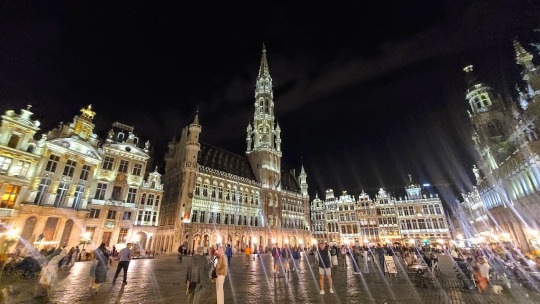

Manneken Pis - just a 5 minute walk from the Grand Place is the famous peeing boy, less than 2 feet tall. Everyone complains the statue is smaller than you’d think. After 400 years, someone thought of adding also a female version of the statue, called Janneken Pis.
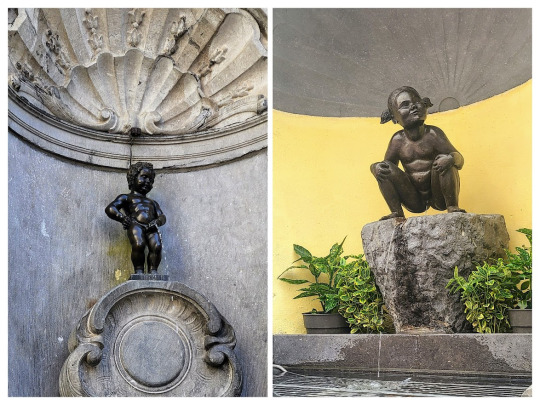
i like how the Belgians didn’t take themselves too seriously and combined that with the other Belgian favorite, waffles; also nice gender equality.
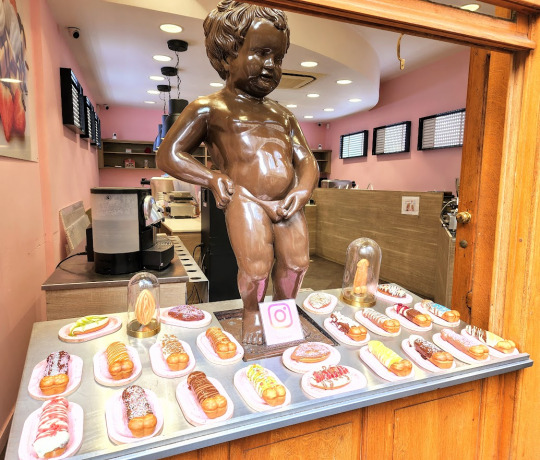
Mont des Arts - our friend explained there’re many beautiful art deco buildings in the area because Belgium got rich in the early 1900s from its Congo colony, a dark past.



Nearby is the royal palace with a nice big park across the street. We really enjoyed hanging out at the beer garden in the park. And the kids rode scooters all around.


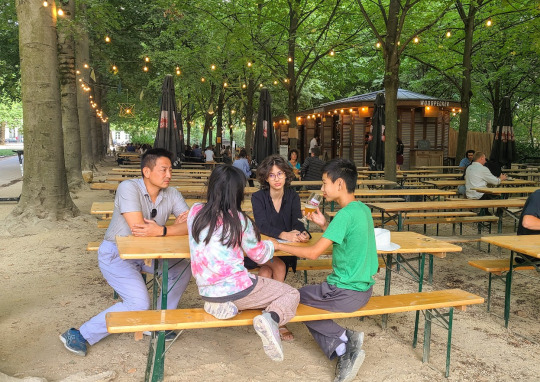
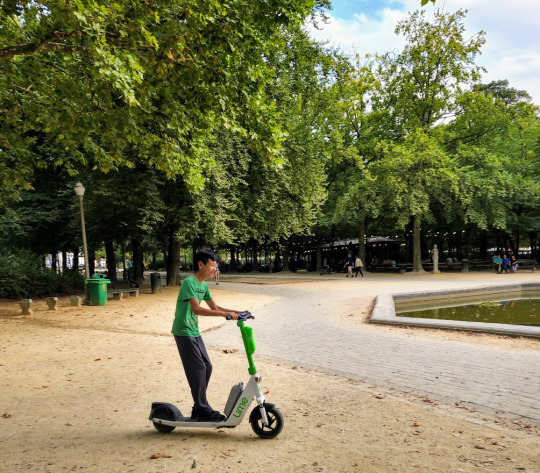
Where to stay
We stayed right between the Grand Place and Mont des Arts, quite convenient. Lodging in Brussels is half the price of Amsterdam. The 4 kids got to stay in their own apartment for less than $200 a day, even though we only booked the day before.
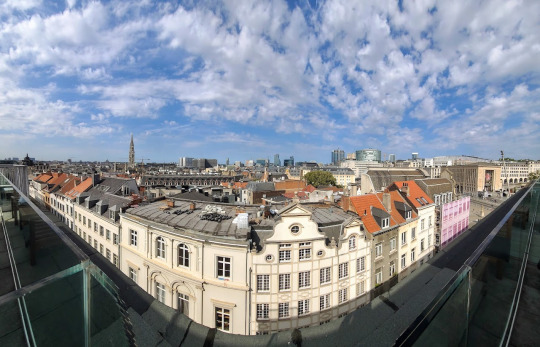


Walking around - It’s so fun to walk around town in the morning when it’s quiet all around.


Food
Belgian chocolates are world famous. There are many fancy chocolate stores throughout Brussels.

Finding good restaurants turned out to be not easy, there are many tourist traps around the Grand Place, despite being highly rated on Google Maps Thankfully our friend met up with his Anglo-Belgian friend who took us to a great seafood place called Bij den Boer. I enjoyed the scallop carpaccio and love loved the Greenland fish Turbot made with miso sauce.


There’s even an interesting pasta restaurant Pasta Divina. The nice owner explained her mother is from Bologna. Their signature squid ink pasta was solid, but the Bolognese pasta that my son ordered was amazing! My son remarked that in hindsight that was smart ordering.
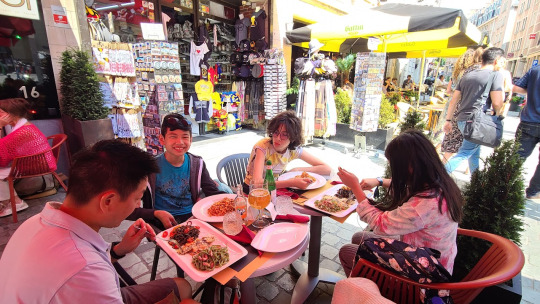
I love how there’s a Delhaize convenient store right around the corner, where we can get delicious Belgian milk, smoothie, meats and croissants for cheap.

Last tip: be sure to book international train tickets early. Ours were quite expensive due to last minute purchase. Otherwise it’s quite convenient to train from Paris to Brussels, just 1 hour 15-20 mins.

0 notes
Photo

Last pavilion to visit : #belgium 🇧🇪 my next destination to #europe 🇪🇺 Diversity in harmony. The 'Green Arch' exhibits Belgian industrial, technological and scientific know-how, reflecting 'belgitude', a mix between Latin romanticism in art and Anglo-Saxon technical precision in industry. (à Expo 2020 Dubai) https://www.instagram.com/p/CcVwEkwLciK/?igshid=NGJjMDIxMWI=
0 notes
Photo
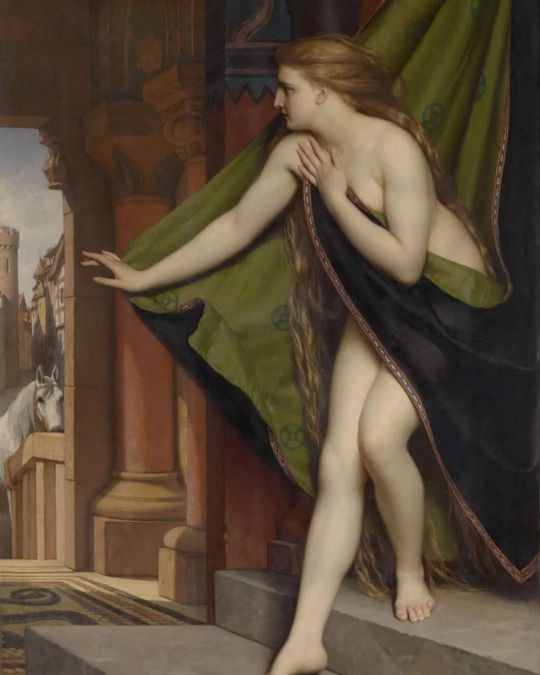
Joseph Henri François Van Lerius (23 December 1823, Antwerp – 29 February 1876, Mechelen) was a Belgian painter in the Romantic-Historical style. His notable students were Lawrence Alma-Tadema, Aloïs Boudry, Gerard Portielje, Henri Van Dyck and Piet Verhaert. Lady Godiva, 1870 (Lady Godiva (died between 1066 and 1086), in Old English Godgifu, was a late Anglo-Saxon noblewoman who is relatively well documented as the wife of Leofric, Earl of Mercia, and a patron of various churches and monasteries. Today, she is mainly remembered for a legend dating back to at least the 13th century, in which she rode naked – covered only in her long hair – through the streets of Coventry to gain a remission of the oppressive taxation that her husband, Leofric, imposed on his tenants.) Royal Museum of Fine Arts Antwerp Public domain Wikimedia Commons . #drawing #art #illustration #draw #sketch #artist #artwork #sketchbook #instaart #painting #manga #anime #digitalart #pencil #creative #artoftheday #arts #artvisual #artsy #kawaiimiimi #doodle #instagood #design #drawings #illustrator #picture #artistsoninstagram #pen #instaartist #beautiful https://www.instagram.com/p/CaTsDyiP9OO/?utm_medium=tumblr
#drawing#art#illustration#draw#sketch#artist#artwork#sketchbook#instaart#painting#manga#anime#digitalart#pencil#creative#artoftheday#arts#artvisual#artsy#kawaiimiimi#doodle#instagood#design#drawings#illustrator#picture#artistsoninstagram#pen#instaartist#beautiful
1 note
·
View note
Text
Top Ten Favorite Movies Set in the 1930s

Below is my current list of favorite movies set in the 1930s:
TOP TEN FAVORITE MOVIES SET IN THE 1930s

1. "Indiana Jones and the Temple of Doom" (1984) - In this exciting second installment of the Indiana Jones franchise, the intrepid archaeologist is asked by desperate villagers in Northern India to find a mystical stolen stone and rescue their children from a Thuggee cult practicing child slavery. Directed by Steven Spielberg, the movie starred Harrison Ford as Dr. Henry "Indiana" Jones.

2. "The Sting" (1973) - Paul Newman and Robert Redford starred in this excellent Oscar winning movie about a young drifter who teams up with a master of the big con to get revenge against the gangster who had his partner murdered. George Roy Hill directed.

3. "Death on the Nile" (1978) - Peter Ustinov made his first appearance as Hercule Poirot in this superb adaptation of Agatha Christie's 1937 novel about the murder of an Anglo-American heiress during a cruise on the Nile. John Guillermin directed.

4. "Chinatown" (1974) - Roman Polanski directed this outstanding Oscar nominated film about a Los Angeles private detective hired to expose an adulterer, who finds himself caught up in a web of deceit, corruption and murder. Jack Nicholson and Faye Dunaway starred.

5. "Gosford Park" (2001) - Robert Altman directed this Oscar nominated film about a murder that occurs at shooting party in 1932 England. The all-star cast includes Helen Mirren, Kelly MacDonald, Clive Owen and Maggie Smith.

6. "Evil Under the Sun" (1982) - Once again, Peter Ustinov portrayed Hercule Poirot in this entertaining adaptation of Agatha Christie's 1941 novel about the murder of a stage actress at an exclusive island resort. Guy Hamilton directed.

7. "O Brother, Where Art Thou?" (2000) - Ethan and Joel Coen directed this very entertaining tale about three escaped convicts who search for a hidden treasure, while evading the law in Depression era Mississippi. George Clooney, John Tuturro and Tim Blake Nelson starred.

8. "Murder on the Orient Express" (1974) - Albert Finney starred as Hercule Poirot in this stylish adaptation of Agatha Christie's 1934 novel about the Belgian detective's investigation into the death of a mysterious American aboard the famed Orient Express. Sidney Lumet directed.

9. "Indiana Jones and Raiders of the Lost Ark" (1981) - Harrison Ford made his first appearance as Dr. "Indiana" Jones in this classic movie, as he races against time to find the iconic Ark of the Covenant that contains the Ten Commandments before the Nazis do in 1936 Egypt. Steven Spielberg directed.

10. "Seabiscuit" (2003) - Gary Ross directed this excellent adaptation of Laura Hillenbrand's 2001 book about the famed race horse from the late 1930s. Tobey Maguire, Jeff Bridges, Chris Cooper and Elizabeth Banks starred.

Honorable Mention: "Road to Perdition" (2002) - Tom Hanks, Tyler Hoechlin and Paul Newman starred in this first-rate adaptation of Max Collins' 1998 graphic comic about a Depression era hitman who is forced to hit the road with his older son after the latter witnesses a murder. Sam Mendes directed.
#indiana jones and the temple of doom#harrison ford#indiana jones#steven spielberg#george lucas#the sting#George Roy Hill#paul newman#robert redford#death on the nile#death on the nile 1978#agatha christie#hercule poirot#peter ustinov#david niven#mia farrow#lois chiles#chinatown#chinatown 1974#robert towne#roman polanski#jack nicholson#faye dunaway#gosford park#robert altman#helen mirren#Clive Owen#Kelly MacDonald#Michael Gambon#evil under the sun
9 notes
·
View notes
Photo

Orchard at La Louvière, Alfred William Finch, 1890
#art#art history#Alfred William Finch#landscape#landscape painting#Post-Impressionism#Pointillism#Belgium#Belgian art#Anglo-Belgian art#19th century art#Ateneum
36 notes
·
View notes
Quote
Glass-Boned Woman is an electronic music project which combines the duelling talents of multi-instrumentalist composer Hell Seb and anglo-belgian chanteuse and lyricist Dominique Van Cappellen-Waldock.
There is a beautiful set of paradoxes inherent in Glass-Boned Woman’s debut album Forest of Souls, involving light and darkness, light and heaviness, art and pop. But for all of the diametrical oppositions this suggests, there is a terrific synthesis that ultimately resolves all of those polarities into a wonderfully interwoven sequence of instrumental and vocal music.
Inspired by modern themes of environment, mortality and human (dis)connection every light, playful element is counterbalanced by something altogether darker - like black rain clouds slowly enveloping a clear blue sky.
0 notes
Text
Noir, Retro and Streamline/Modern Comics
Retro Comics in childhood

In childhood, when reading Metal Hurlant (the Latin version of Heavy Metal), I was exposed to many of the European comic artists. Some were either a noir, retro and/or streamline modern.

Of course that back then I didn’t realize it. In fact, I didn’t like much any kind of black and white comics, even if I did read them.
Still, I liked some of them, even the ones that didn’t rely heavier on the shading and chiaroscuro techniques that make a good noir comic.

When I was a kid, I liked anthology Franco-Belgian comics that now I realize are noir. When back then I tried to figure out why I liked them, I thought I liked them because of their retro and streamline modern styles.

My favorite bande dessinée (FB comics) artist is Denis Sire. Pity that most of his output is in French, a language that I still don’t command.

Pity that we lost him last month. Maybe now he is in a better existence, in a world featuring female persons that look more like the pin-up-like girls he used to draw than the women of the earth.

Denis Sire said that his main influences were the Will Eisner and Dave Stevens’s Bettie Page’s illustrations.

Sire’s illustrations of Lisa Bay attest to that statement.

The Metal Hurlant anthologies were I knew all of my favorite Europan comic artists was very noir. Even if it was an outfit owned by more SF-oriented authors, was the conduit for all those noir and retro artists to run the show, which they did.

Recent Noir and Retro Comics I read
I said in my previous post on horror comics that Hellblazer should be like scripture for those horror fans that read comics. Tonight I say the same for those who, like me, like a blend of horror with noir.
Some runs of Hellblazer (like for instance the one that Corben illustrated) can definitely be called horror noir.

I have read more than two-hundred issues of this series, and not a single run did let me down. Except maybe for Constantine’s season in Ireland. If that run was the less noir of all, I guess it was due to its hippy-flavored story and location.
That said, I want to mention Sin City, a comic that I didn’t put in my list of horror comics for obvious reasons. I thought of it, and realized, that even if minuscule if compared to other books, it has several horror elements.
I mean, besides the violence and gore, there is a certain creep factor to the Roark’s and their backstory.

Of all the noir comics I read, I must say Sin City is my favorite. Even if it lacks more of the supernatural and takes itself way too seriously, like I believe it does.

Going on a superhero tangent, let’s not forget Watchmen. This series has a noir run, which I haven’t read. But the original Watchmen series of around a dozen comics also integrates elements neo-noir to its story and art.

The Crow is neo-noir horror and each run works upon the original story with different characters. By the way, The Crow, Watchmen, and Sin City all have fantastic movie counterparts, that highly recommend watching to those who love film noir.

Last but not least, Lobster Johnson. It’s part of the Hellboy series and it's so heavily noir in its art that I’d say it’s my second favorite after Sin City.
Outro
But my retro love goes way back than streamline modern, noir and neo-noir styles. I also love everything belonging to the Gothic and Anglo styles. Specially Anglo style, I love everything retro in the Anglo sensibility.
By Anglo-retro I mean everything salvageable from the Elizabethan, Georgian, Regency and Victorian periods. But back to noir and retro.
I chose noir as a subject of study. Until I arrive at not just encyclopedic knowledge of it, but also some higher realization that I still don’t know what will be.
I made a search for story type noir in comics.org and got more than 1500 results. 1179 in English, so noir is popular, at least with artists, writers and publishing houses.
Comicbook realm.com gives 61 results for the query “noir”. I wonder why there’s such an imbalance between both sites, I’ll find that out.
I leave you with a piece of trivia about comics with noir stories in English. Based on a query in comics.org:
The oldest American Comic Books with a Noir Theme
(You can click the titles to buy any comic of these series at mycomicsshop.com)
Manhunt

The hand of fate

Crime Detector

Worldwide Retro, Streamline and Noir

Keywords for Noir Comics:
Cossu
Chaland
Benoit
Clerc
Sire
Montellier
Eisner
Miller
Moore
Tardi
Ceppi
Voss
Schuiten
Breccia
Dynamite Entertainment
Chevale Noir
(to be expanded and given more context later)
0 notes
Text
Early Middle Ages
Chapter 11 is about the Early Middle Ages of art. This chapter is unique to me because it has a lot of Islamic Art and they don’t have any Sculptures in this chapter. They have beautiful Cathedrals, Religious paintings and the Architecture of the Palace Chapel. Architecture is the many focus of the art of the Middle Ages.
Great Mosque in Cordoba, Spain is a beautiful cathedral. it has very short and pretty columns that have arches at every top of the column. At each top, it had white and red strips. Christian were the ones to turn this into a Church in the Thirteen Century. Then in the sixteenth century this Cathedral had part of the Mosque damaged because of when they built the Cathedral.
I thought reading about Anglo-Saxon Metalwork was interesting because of the Purse that was discovered. It was discovered by the Pagan Ship Burial. The Purse cover’s decoration is pf gold and dark red garnets. The face of the purse was symmetrical and the top has two geometric shapes that is a Hexagon. Then in the middle top it looks like two circles over lapping each other. The middle of the purse is two animals fighting whose legs and jaws are extended into a tracery of intertwined ribbons. This Purse covering is beautiful and it has a means in the Early Middle Age art.
The Palace Chapel is the last decade of the Charlemagne moved in his capital and his court to Aachen,45 miles from now known as Belgian-Dutch border. They chapel had is features that had common pieces with San Vitale in Ravenna. San Vitale is Octagonal and the palace chapel has 16 sides. Charlemagne used the arts to make his political image better. This palace is looks like a huge place even now days.
Out of all three paintings in this chapter I really enjoyed the Four Evangelists. It is telling us that there are saints symbols set in the background. There are four guys that are studying the Gospel book at the Palace Chapel School. The artist that made this painting came from Constantinople and that put some Hellenistic traditions.
1 note
·
View note
Photo
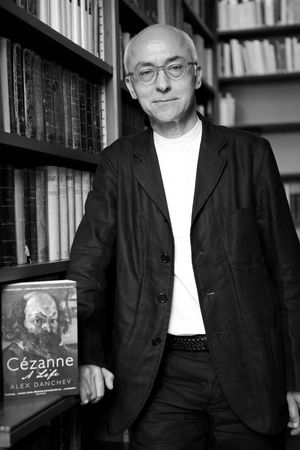
The historian and biographer Alex Danchev, who has died aged 60 from a heart attack, believed that it was artists rather than politicians who had the power to change society.
Danchev made his name as a military historian, with acclaimed biographies of Oliver Franks (1993) and Basil Liddell Hart (1998), and a co-edition of the unexpurgated war diaries of Lord Alanbrooke (2001). More recently, artists had become his focus, although he continued to write about contemporary politics, notably Anglo-American relations and the so-called war on terror. A life of Georges Braque (2005) – the first ever to be published – was succeeded by a life of Braque’s “god”, Paul Cézanne (2012), and Danchev’s meticulous and tone-perfect new translation of Cézanne’s letters (2013) – letters which had formed the backbone of his subtly revisionist interpretation of the artist’s character and behaviour.
An anthology of 100 artists’ manifestos published between 1909 and 2009, including those by Boccioni, Malevich, Barnett Newman and Gilbert and George, came out in 2011. In all these well-received books – and his many essays on contemporary painters, photographers and film-makers – Danchev deployed to brilliant effect his knowledge of the literary culture that helped to form his subjects’ work and thinking. He also wrote beautifully about the visual qualities of the art.
His biography of René Magritte – a painter for whom poetry and philosophy were prime sources of inspiration – was incomplete at the time of his death.
If this mixture of military history, philosophy, poetry and avant-garde art seems eccentric, for Danchev the interrelationships were essential. As he put it in the introduction to On Art and War and Terror (2009), “Armed with art … we are more alert and less deceived.” Artists (in the broadest sense of the term) being exceptionally acute “witnesses” of their times must, he argued, be taken seriously as thinkers and moral agents; their works have political and ethical force. Seamus Heaney’s statement, “The imaginative transformation of human life is the means by which we can most truly grasp and comprehend it” was, he said, his credo.
In the essay on Anselm Kiefer published in On Good and Evil and the Grey Zone (2016), Danchev expressed this controlling insight in characteristically pungent style: “Contrary to popular belief, it is given to artists, not politicians, to create a new world order.”
Alex Danchev was born in Bolton, Lancashire. His father, Alfons Danchev, was a mining engineer of Belgian and Bulgarian parentage who moved to London to complete his training in 1939 and, having worked for the BBC World Service during the second world war, became a British citizen in 1947. His mother, Anne Gilman, worked in the fashion industry. This background no doubt contributed to Alex’s dislike of conventional boundaries and eventually to the impassioned opposition to binary thinking (“us and them; black and white; good and evil; civilisation and barbarism”) expressed in the essays gathered in On Art and War and Terror, and On Good and Evil and the Grey Zone.
A first-class degree in history and economics at University College, Oxford (1977), and a postgraduate teacher-training certificate at Trinity Hall, Cambridge, were Danchev’s passport to Sandhurst in 1978 and the start of a decade as an officer in the Royal Army Education Corps. Meanwhile, he completed a PhD in war studies at King’s College London (1984). A research fellowship at King’s in 1988-89 spelled the end of his army career and led to a lectureship in international relations at Keele University, with promotion to professor and head of the department in 1992.
From Keele, he moved in 2004 to the school of politics and international relations at Nottingham University, and from there, finally, to St Andrews University in 2014. Successive high-profile visiting fellowships at Queen Mary University of London and St Antony’s College, Oxford (2008-10), reflected the esteem in which his work was held.
Danchev’s energy was phenomenal: his commitment to teaching, for which he won several awards, remained intense despite his stream of publications, arduous administrative duties and membership of august editorial boards.
Somehow, he also found time to review regularly for the Times Higher Education and Literary Supplements, the London Review of Books and the Guardian. Reviewing sometimes triggered a major new project. Thus an exuberant response in the THE to the Magritte exhibition at Tate Liverpool in 2011 – “My advice: jump on a train to Liverpool and marvel afresh at all the things there are to marvel at” – was the catalyst for his unfinished biography of the artist.
Among the qualities that made him so original and stimulating a historian of 20th-century and contemporary politics and art was his imaginative and creative response to an exceptionally wide range of cultural material. Typically, he prefaced his essays with quotations from thinkers and writers that proved to be perfectly apt, but that belonged to a period or milieu seemingly different from that of the subject in hand. Thus a sharply worded assessment of Tony Blair’s role in the Iraq war was introduced by Aristotle’s Ethics.
Montaigne, Proust, Nietzsche, Kafka, Rilke and Beckett were among favourite points of reference, but the chorus of voices was neither stable nor predictable: it was always expanding to admit discoveries or rediscoveries. So, following a characteristic pattern, Danchev’s research on Magritte led to his delighted discovery of the underrated Belgian Surrealist poet Paul Nougé, who duly joined the select company worthy of quotation in an epigraph.
Thinking laterally was one of Danchev’s fortes and the mot juste another, for the dazzling erudition never came with the heavy hand of the pedant, but with the striking turn of phrase of the enthusiast keen to share with his readers the joys and revelations afforded by the books that had marked him.
In his life and in his work Danchev was sustained by his partnership with the psychologist Dee Cooper, whom he married in 1998 and who, he said, immeasurably deepened his understanding of the complexities of human nature.
A devotee of jazz, he relished good company and the good things of life, while not seeking to conceal his streak of moral earnestness. He is survived by Dee, his step-daughters, Sarah and Jemma, and his step-grandchildren, Alexander and Isabella.
Daily inspiration. Discover more photos at http://justforbooks.tumblr.com
2 notes
·
View notes